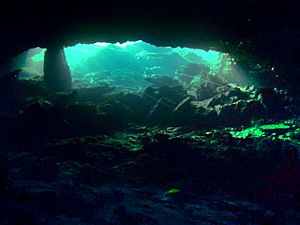Wes Skiles Peacock Springs State Park facts for kids
Quick facts for kids Peacock Springs State Park |
|
|---|---|
| Location | Suwannee County, Florida, USA |
| Nearest city | Live Oak, Florida |
| Area | 733 acres (297 ha) |
| Governing body | Florida Department of Environmental Protection |
Wes Skiles Peacock Springs State Park is a cool state park in Florida, covering about 733 acres (297 hectares). You can find it near Luraville and Live Oak, Florida. This park is a great place for outdoor fun like picnicking, swimming, and even cave diving.
When you visit, keep an eye out for amazing wildlife! You might spot deer, bobcats, raccoons, squirrels, beavers, and otters. Look up to see turkeys, blue herons, and barred owls. The park is named after Wes Skiles, a famous diver and explorer who did a lot of work here. Before 2010, it was simply called Peacock Springs State Park.
The park has a nature trail, six sinkholes, and two main springs: Peacock Spring and Bonnet Spring. These springs are connected by miles of underwater caves, which are super popular with cave divers. Both springs flow into the Suwannee River. The park is open every day from 8:00 AM until sunset.
Contents
Park Growth and Expansion
In 2006, the park got much bigger! The Trust for Public Land bought about 481 acres (195 hectares) of land and added it to the park. This more than doubled the park's size, which was originally 252 acres (102 hectares). This expansion helps protect more of the natural area and its amazing cave system.
Exploring the Cave System
The Peacock cave system is a huge network of underwater passages formed in limestone. This type of landscape, with caves and sinkholes, is called karst.
People started exploring the Peacock Springs Cave system way back in 1956. The first detailed map of the system was made in 1995 by a team led by Sheck Exley, a well-known cave explorer. His team made over 521 dives to create the map! Later, in 2010, divers Agnes Milowka and James Toland found a connection between Baptizing Spring and Peacock Spring. This discovery added another 10,000 feet (3,000 meters) to the total length of the cave system, making it even larger.
To help protect the delicate cave system, the park stopped allowing divers to use Diver Propulsion Vehicles (DPVs) in 2002. These are underwater scooters that can stir up silt and potentially damage the cave.
Peacock Springs is one of the biggest underwater caves in the United States, with over 38,000 feet (11,582 meters) of explored passages. It's a famous spot for cave divers from all over the world and is often used to train new cave divers because of its many different tunnels and features.
Springs and Sinkholes to Discover
The Peacock Springs system has several important springs and sinkholes. Six of these are located right inside Peacock Springs State Park.
Peacock I Spring
Peacock I Spring is the easiest and most popular spot for divers. It has a raised walkway and stairs that lead right into the spring. Three main underwater tunnels meet at this spring: the Pothole tunnel, the Peanut tunnel, and the Peacock II tunnel. Each of these tunnels has a permanent guideline, called a "gold line," to help divers find their way safely.
Pothole Tunnel
The Pothole tunnel is named after a sinkhole about 450 feet (137 meters) into the tunnel from Peacock I. It's the deepest of the three tunnels, reaching about 65 feet (20 meters) deep. This tunnel has wide passages and high ceilings, but its bottom is often covered in silt.
Peanut Tunnel
The Peanut tunnel is shallower and narrower. It's named for a section that looks like a peanut. Its depth changes from 20 to 60 feet (6 to 18 meters). About 500 and 1,000 feet (152 and 305 meters) into this tunnel, there are crossover tunnels that connect it to the Pothole tunnel.
Peacock II Tunnel
The Peacock II tunnel is the path that leads to Peacock II Spring.
Peacock II Spring
Peacock II Spring is smaller than Peacock I. It's one of only two places in the park where regular open water divers can go, as it doesn't connect to the larger cave system.
Olsen Sink
Olsen is a small sinkhole about 1,500 feet (457 meters) from Peacock I along the Pothole tunnel. It used to be a popular entry point for cave divers because it offered good access to many parts of the cave. However, to prevent damage to the area, divers are no longer allowed to enter at Olsen Sink since 2002. It's still a common place for divers to surface briefly during a dive.
Orange Grove Sink
Orange Grove is a large sinkhole located northeast of Peacock I. It has a raised walkway and stairs, making it a popular entrance for divers. Two winding tunnels extend from this sinkhole: Lower Orange Grove and Upper Orange Grove. Lower Orange Grove is a deeper tunnel, going down to 180 feet (55 meters). Upper Orange Grove is a winding tunnel that changes depth from 70 feet (21 meters) to 40 feet (12 meters). This tunnel even extends outside the park to Challenge Sink.
Challenge Sink
Challenge is a sinkhole that is the northernmost one in the system. It's the only sinkhole not located inside Peacock Springs State Park. It can be tricky to enter and exit because of its steep sides. Divers often use it as a destination when exploring Upper Orange Grove.
Peacock III Spring
Peacock III is a "siphon," which means it takes water in instead of letting it out like a typical spring. It has its own separate cave system from Peacock I and II. This system is generally low and shallow, but it does have one large room called Henley's Castle, which drops to depths of over 200 feet (61 meters).
Images for kids






